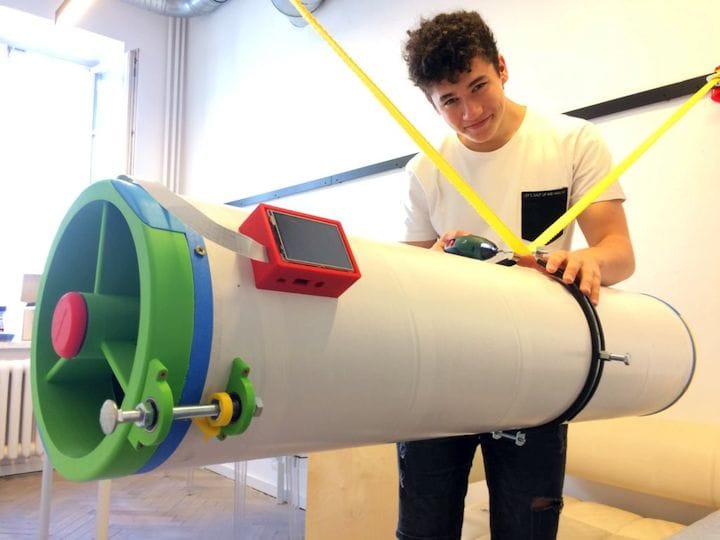![A 3D printed telescope under development [Source: TelescopePrime]](https://fabbaloo.com/wp-content/uploads/2020/05/image-asset_img_5eb0934538bc2.jpg)
This week’s selection is TelescopePrime by Aleksy Chwedczuk and Dr. Jakub Bochiński.
TelescopePrime is a DIY project to build a customized and worling 3D printed telescope that has been contributed to the open source community. Anyone can now build a competent telescope for under an estimated US$400 for required parts.
Dr. Bochinski is an astronomer who studied planets, while Chwedczuk is a 16-year-old student.
The pair decided to embark on the project to make astronomical technology more accessible. They explain:
“Telescopes have long been difficult to get one’s hands on, hard to operate and far from affordable. We decided to start the TelescopePrime project to change that and provide an open-source platform, which can be easily modified and expanded upon to suit every buddying astronomer’s needs while staying below 400$.”
The initial version of TelescopePrime was assembled at Akademeia High School in Warsaw, while the 3D printed parts were provided through Sygnis, a Poland-based 3D print consulting operation that focuses on scientific projects.
3D Printed Telescope Parts
![The completed DIY 3D printed telescope mounted [Source: TelescopePrime]](https://fabbaloo.com/wp-content/uploads/2020/05/image-asset_img_5eb0934563c23.jpg)
Of course, the whole telescope is not 3D printed, as some parts cannot be 3D printed (the mirror and electronics) and others should not be (the main optical tube). These parts are sourced elsewhere, and are commonly found, with the exception of the mirror, which must be ordered from a speciality operation. It’s also possible one could make a mirror from a glass blank, but that requires specialized skills and experience.
Not only have the 3D models of the parts been published for anyone to use, but the CAD model has also been published. An Autodesk Fusion 360 file has been shared for others to duplicate and modify as required.
![The Autodesk Fusion 360 CAD model of the DIY 3D printed telescope [Source: TelescopePrime]](https://fabbaloo.com/wp-content/uploads/2020/05/image-asset_img_5eb0934586b55.jpg)
Parametric Telescope 3D Model
One reason for modification is that the entire design is parametric. It’s therefore possible to specify the telescope properties and the CAD model will automatically resize everything to that configuration.
This capability is quite important as a telescope’s power is proportional to the diameter of the mirror; larger mirrors collect more photons in less time. However, larger mirrors also cost considerably more than smaller mirrors, making an interesting financial and technical compromise decision for those wishing to build TelescopePrime.
Of course, another decision point might be whether the largest component can fit on the 3D printer you intend to use for the project. In the default configuration, the largest part is the “Spider” that sits atop the tube. It’s 270 x 250 x 105 mm, which may be larger than some 3D printing equipment can handle.
Many of the 3D printed parts in this project are used to hold the mirrors and camera. This is actually quite an advantage over building the same components by hand, because the 3D printed parts are designed to hold the other components at the precise location and orientation required to operate the telescope. Just print and assemble.
![The mirror holder, one of the larger 3D printed parts in TelescopePrime [Source: Telescope Prime]](https://fabbaloo.com/wp-content/uploads/2020/05/image-asset_img_5eb09345ab943.jpg)
The electronics of TelescopePrime revolve around a RaspberryPi, which provides logic and control for the system. It’s housed in a neat box that can be 3D printed.
Open Source Telescope
There are 14 separate STL files in the supplied 3D model package. However, some are “slices” and will require printing several units to complete the component. In all, the designers say they spent 156 hours on their Flashforge 3D printer to produce the required 17 parts.
You can attempt building TelescopePrime yourself, as they’ve provided all of the necessary files for free download at their site.
Via TelescopePrime and Sygnis











This week’s selection is a 3D printed Coronavirus!